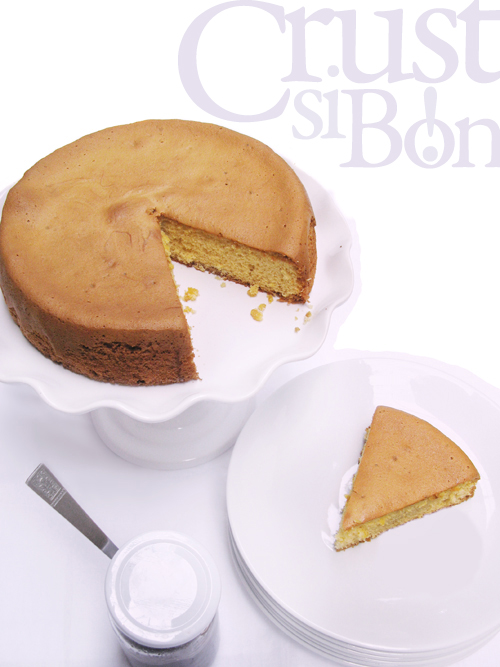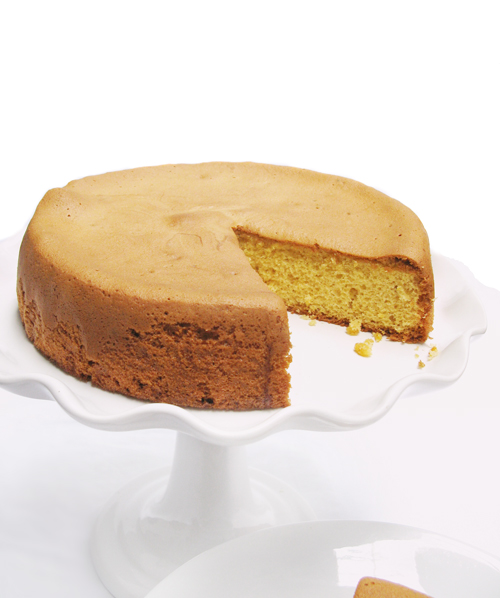Honey Castella


New! This is my entry to Click September 2008: Crusts. Wish me luck! :)
I'm going to have to apologize (again) for what may be the most horrible, forced pun that isn't even that pun-ny. But I didn't have enough time to think of the praises I was going to sing for this cake. It's simply the weirdest, most amazing cake I've ever baked. "But... It's so plain," you might think. And it is: that's part of its charm, what makes it so amazing. It's from the book that Allen gave me, The Sweet Spot by Pichet Ong. It is simply the cake that has been consumed the fastest in this household-- 8 hours (house of 5 people). Really that good.

"Well, this is certainly not up to par with your usual aesthetic," you'll probably tell me (apparently I envision all of my dear readers as sneering cynics, ha ha ha). We've already seen and laughed at those Cake Wrecks. We've been traumatized by the horrors that some unsavory folks at the Food Network have unleashed on us. (By the way, if you read the reviews, one person said that she "made the cake in the morning for my husband and I and by that evening it was gone." Because they sent it speedily on its way down the garbage chute?) I promise that you will not feel the need to defile this cake by adding frosting to it (the jam you can see in the picture I took? It's a mistake). It's already been specially engineered by skillful Nagasaki bakers (inspired by the Portuguese who introduced the Pão de Castela) to have a superior crust and lovely crumb. The crust is dark (actually supposed to me much darker than mine), sweet, smooth, and silky. The crumb is dense and moist. Just unmarred perfection.
However, I did make a major change in the size of the cake. Originally it's meant to be in a 9"x13" pan, but I don't have one. So to make it in an 8" round pan with the same height, all I have to do is divide the areas: (3.14)(4)(4)/(9)(13)=0.42. Here's where the magic of the metric system comes in: just multiply the quantities by the factor. What about the 7 eggs and 3 egg yolks? Since I don't really remember how much an egg yolk weighs, I just add all the whites together (7) and the yolks (10) and multiply each by 0.42, giving 2.8 whites and 4.2 yolks. Round them to the nearest one and you get 3 whites and 4 yolks, or 3 whole eggs and 1 additional egg yolk. Easy peasy. The baking time is the only step that'll be difficult, but not a problem for me! :)
By the way, the Obstetrics and Gynecology postgraduate course has already gone public, so it's with mild excitement that I present to you the posters that I was commissioned to make (click to enlarge). The background of the one in Boracay is an actual picture taken by me at that beach; the painting of the pregnant woman was sketched by hand and painted in Photoshop. My influence for this design is from clean Swiss modern design, in contrast to the Art Nouveau/ Parisian influence I used in the last one (my progress on that work is here, and my work from the year before that is here).
I'm aware that the second poster looks unbalanced by the visual weight of the magnifying glass versus the white space above it. However, the committee wasn't so hot on the word "Based" being partially hidden. I argued that any physician worth his/her salt would not mistake the word after "Evidence" for anything else. I lost. Here's the original:
P.S. Jason of Jason Cooks has awarded me with a Brillante Award. Thanks so much, Jason!! :)
Honey Castella adapted from The Sweet Spot
True Castella from Nagasaki does not contain any added oil, which makes Ong's recipe unique. There are also several other techniques in traditional Castella that I don't use here: sprinkling the batter with coarse sugar that settles at the bottom and makes a dark, sweet bottom crust, taking out the cake halfway through baking and disturbing it to destroy the air bubbles and make the cake dense, and baking in a covered container to steam the cake. You will also notice there is a slight fall in the cake, which creates a raised rim of crust. This didn't bother me, but if you don't like the effect, you can cool the cake upside-down: just be careful to do so on a greased surface so you won't lose any of the precious crust.
- 88g (1/2 cup + 2 tablespoons) all-purpose flour
- 3 large eggs, at room temperature
- 1 large egg yolk, at room temperature
- pinch of salt
- 126g (1/2 cup + 2 tablespoons) granulated sugar
- 42g (1 tablespoon + 2 teaspoons) honey
- 22g (1 tablespoon + 2 teaspoons) canola or other neutral oil (you may also use the same weight, or 1-1/2 tablespoons of butter, melted)
Preheat the oven to 175°C (350°F). Spray an 8-inch round pan with baking spray and line the bottom and sides with parchment. Don't spray the parchment after lining. Sift the flour onto a sheet of wax paper or a bowl and set aside. In a heatproof (or mixer) bowl, add the eggs, egg yolk, salt, sugar, and honey. Place this over a saucepan of simmering water and beat on medium speed with a hand mixer (or use a whisk) for 10 minutes (the mixture will be at least 40°C, or 104°F). Take off the heat and beat on high speed for at least 6 more minutes using a hand mixer (or 10 minutes on a stand mixer if you started out with a whisk). The batter will be cool, pale and form very thick ribbons that take a very long time to sink completely into the surface of the batter.
Gently fold in the flour into the batter in 3 additions. Take about 1/2 cup of the batter and whisk it into the oil until completely homogeneous, then drizzle it back into the batter, folding continuously as you add it.
Pour the batter into the prepared pan and bake for 20 minutes, then turn the heat down to 150°C (300°F) and continue baking for 18-25 more minutes, or until a toothpick inserted into the center comes out with a few very fine crumbs. Cool the cake completely (cool inverted on a sheet of greased parchment if desired). Unmold to a serving platter.















































